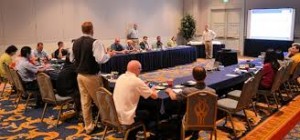Archive for January, 2018
The Intervention Phase
Top-down change management creates the problem of resistance with leaders battling to motivate and engage. OD supports organizational change by utilizing their people resource. Rather than creating barriers and a culture of fear, OD intervention methods should be designed to enable people to speak up.

Once the Diagnostic Phase has been completed, the feedback report should provide the information needed to design a robust action plan for OD interventions that will enable the organization to continue its change journey. By this point the disturbance process should be in full effect and options for OD techniques and methodologies can drive real behavior change as well as change to structure, process, and policy. Interventions can be devised to address a number of organization system requirements sustaining and maintaining some elements, consolidat- ing progress made, building on strengths, or preparing for future changes. Interventions can be limited to examining a single issue or an ongoing program of interventions designed for progressive development. At the core of each OD intervention is the search for existing organizational capacity, which can help progress the organization toward prospective futures.
Based on the theoretical underpinning of OD practice, there are a number of OD tools and techniques available to the OD practitioner. Key questions to be addressed during that the Intervention Phase are:
■ Where and at what level within the organization should the intervention be deployed?
■ What specific areas of change are required and to whom: individuals, teams, functions, or the whole organization?
■ What is the focus of the intervention: task, process, or people?
■ Given the organization culture should interventions be rigorously planned or will the change journey be emergent?
■ What intervention tools and techniques best t the organizational environment and have the potential to deliver the outcome required?
■ Who within the organization will be in- volved in codesigning interventions alongside the OD practitioner?
■ What actions can the OD practitioner take to improve the client’s ability to deal with future problems?
An Intervention Model—Harnessing the Human Resource
OD interventions should engage with the tripartite of thinking, feeling, and being, which is central to human endeavor. Harnessing the Human Resource within the organization requires that each intervention engages with rational logic, awareness and self-awareness, and transpersonal elements of the change process.
Reasoning
OD creates space for individuals to think using iterative methods of action and re- ection. It grants access to the full range of intellectual capacity and knowledge depositories within the organizational boundary allowing for a high-level interchange of ideas and information. Reasoning creates an arena, which allows individuals to utilize the intellectual capacity available within the organization, resulting in solutions that are broader in scope, thought through, innovative, and creative.
Observance
The links to behavioral science mean that OD interventions encourage people to watch, notice, perceive, and observe their own behavior and that of others within the organization. Sometimes referred to as emotional intelligence, the act of increasing awareness into how people behave and exploring why they behave in that way in- creases an observance of behavior, which, once noticed, can be developed.
Appreciation
OD engages with individuals to appreciate their own, and others’, feelings, values, and beliefs. This appreciation transcends the requirement to be right, and instead develops a connection even in difference. Clear perception and recognition of how individuals activate their beliefs and values results in greater levels of understanding and appreciation, which enables personal peak performance.
The OD Tool Kit—What you Need for the Intervention Phase
The intervention phase is the beating heart of the OD program and harnesses the human resource in the organization to create a safe environment where ideation, creativity, and innovation are utilized to overcome challenges and pursue opportunities. The techniques and methods required for the intervention phase of the OD cycle are:
- Acknowledgment of complexity
- Cultural sensitivity
- Knowledge and methods relating to adult learning and learning through play
- Knowledge and skills in employing OD Methods, for example:
- Community Learning (Fulton, 2005)
- World Café (Brown and Issacs, 2007)
- Open Space Technology (Owen, 2008)
- Charrettes (Lennertz, 2003)
- Theory U (Scharmer, 2009)
- Work-Out (Ulrich et al, 2002)
- Sustained Dialogue (Saunders, 2012)
- Ability to develop supportive and safe environments
- Flexibility and adaptability to respond to the ow and messiness of the intervention environment
Summary
■ OD supports organizational change by utilizing the people resource.
■ The feedback report from the Diagnostic Phase should provide the information needed to design a robust action plan for OD interventions.
■ At the core of each OD intervention is the search for existing organizational capacity, which can help progress the organization toward prospective futures.
■ Harnessing the Human Resource within the organization requires that each intervention utilizes reasoning, observance, and appreciation.

